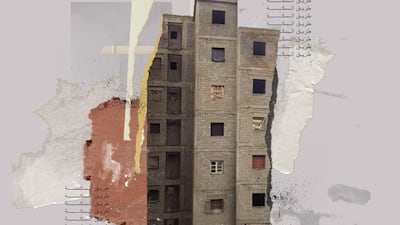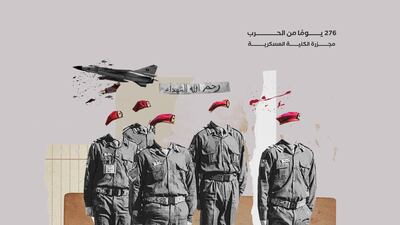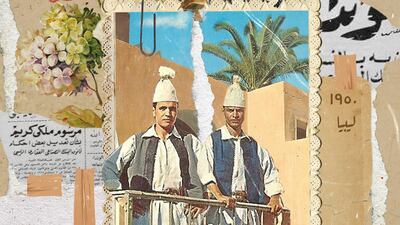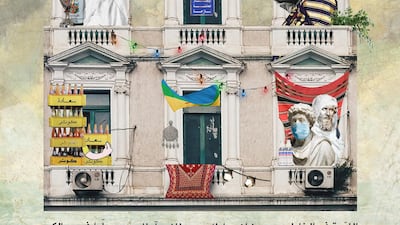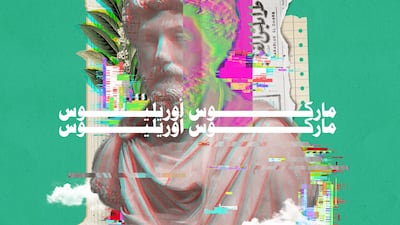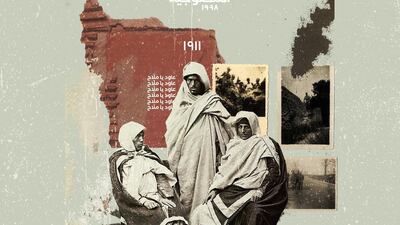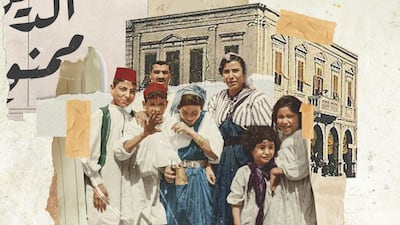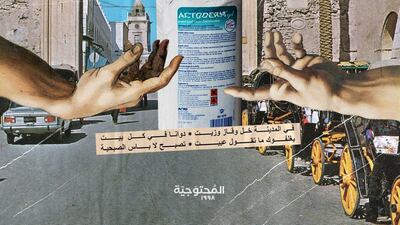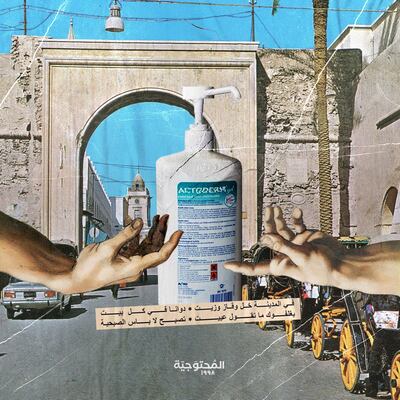The nearly touching hands from Michelangelo's Creation of Adam meet centre frame in one of Razan Al Naas's collages, with Tripoli's historic Bab Al Madina in the background. The hands are upended, palms towards the nozzle of a large bottle of hand-sanitiser.
This meeting of disparate subjects might sound like a lot going on in one picture, but the Libyan artist manages to make the collage a cohesive whole, and with a grainy aesthetic reminiscent of vintage posters.
The collage, which was published on Al Naas’s Instagram page in March, also features an excerpt from a poem by Libyan writer Naseer Tweebi that translate as: "In the city we have vinegar, gas, oil / a cure in each and every house / it heals you like nothing ever happened / and you wake up just fine the next day."
"I made this piece when we still had zero cases of Covid-19," Al Naas tells The National. "The poet is talking about how the people of Libya are always ready for the worst, and situations like getting sick. I found that it fit perfectly with the collage and the idea of having zero cases."
Since then, there have been a reported 64 cases of the coronavirus in Libya, with three deaths and 28 recoveries.
While the pandemic has brought the world to a standstill, it has done little to subdue the conflict in Libya, which has reportedly caused the deaths of more than 2,000 people and displaced more than 150,000, including Al Naas and her family, since recent clashes began in April last year.
The situation in Libya moved Al Naas to document the ongoing conflict through a series of digital collages, in which she tries to communicate the feeling of living in a war zone while paying tribute to Libya’s rich and diverse history.
Al Naas has not seen her bedroom for a year. She's not even sure it still exists.
“We’ve been in a war for a year now, and it affects my mental situation and my daily life. We lived in a very dangerous zone where you would hear the bombs go off every single hour,” Al Naas, who is now living at her grandparents’ house in a safer part of Tripoli, says.
“I never stopped thinking about that."

One of her works shows a building of unfinished cinderblocks with blanketed and boarded windows. There are strips of wall plaster and stucco textures within the image. It is dated January 2020 and the bottom right of the collage reads “279 days of war on Tripoli”.
“The conflict has not stopped, and there are people dying every day,” Al Naas says. “I want to tell the world that we’re actually suffering during Ramadan, during Eid, and that we still hear the bombs during the coronavirus pandemic.”
Al Naas was finishing her final semester at the University of Tripoli, where she was studying web development, when the conflict began. The artist – who is now working as a freelance graphic designer – says the university reopened in February 2020, but only briefly.
“We could hear the bombings from our class,” she says. “The university soon closed down again because of the quarantine measures. I remember we had an exam scheduled for the next day when they announced the university was closing, and the last hope of finishing the semester was gone.”
Al Naas begun making her collages in 2016, and it "all started when I learnt how to use Photoshop and its tricks," she says.
“I wanted to represent my own self and my thoughts through collage in four different aspects: cultural identity, emotions, interests, and the civil conflict situation.”
Al Naas says she tries to summarise each of her artworks according to these four aspects. “They inspire me to make more and more pieces,” she says.
Another one of Al Naas’s collages fixates on a bust of the Roman emperor and Stoic philosopher Marcus Aurelius. A rectangle of filtered colours spans a fraction of his face and beard, turning the white of the marble to pink and the shadows under the carvings to a fluorescent green. There is a laurel branch positioned behind the emperor along with a Roman column. On the right of the work, the word Tripoli is written vertically in Arabic. Libya – and the larger area of North Africa – was under Roman rule during the Marcus Aurelius era up until 672 AD.
Libya’s history and cultural identity play an important part in Al Naas’s works. In fact, she says it is her primary source of inspiration.
“The world must know the beauty of our culture, not just because it’s beautiful, but because it’s a mixture of a whole history,” she says, adding that she makes sure to insert some Libyan colloquialisms into her works – such as the one featuring the hands of God and Adam – as the slang is a perfect demonstration of the length and breadth of Libya’s history.
“The slang we use is a mixture of Arabic, Tamazight, Italian, and Turkish.”
Al Naas says she always tries to channel her emotions into her collages. The approach is not only therapeutic, but helps in achieving more cohesive and expressive results.
“I find pictures, papers, textures, brushes and I visualise how it would look like in collage,” she says, adding that she always tries to work on a collage with curiosity, to leave viewers with wonder and have them ask “how do you do that?”
Though Al Naas says that the bulk of her collages are digitally made, she’d also like to try making handmade ones soon.
“My work is always digital because I know how to use Photoshop and you can always find the things you want on the internet. So digital collages are easier to make. But sometimes I think of changing. I’d like to try making handmade collages. I bet it’s even more fun.”
